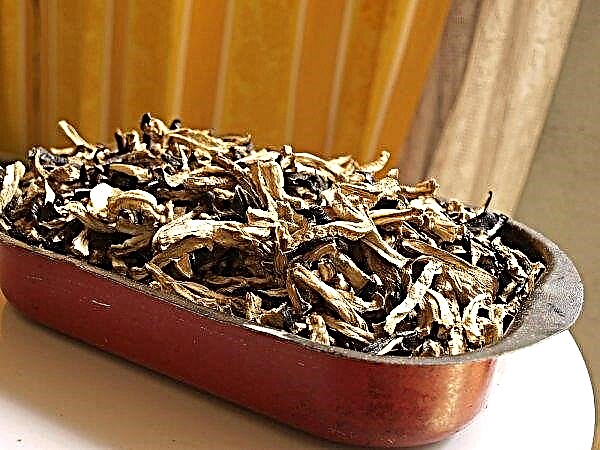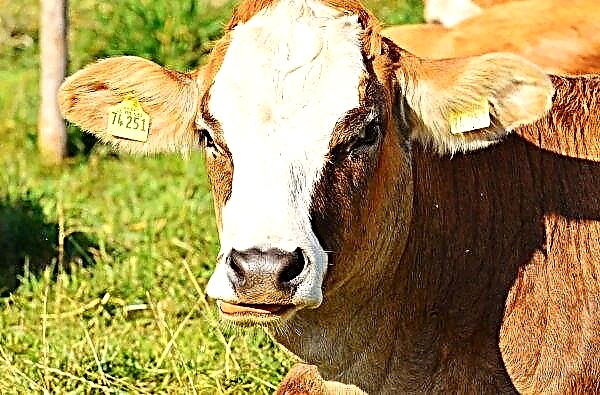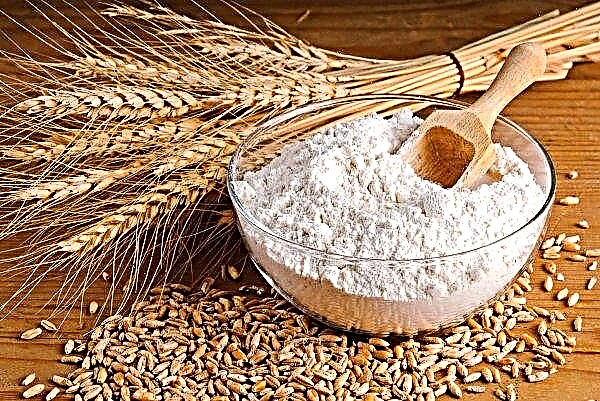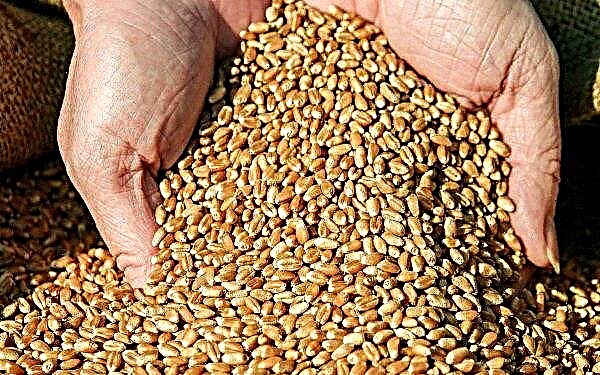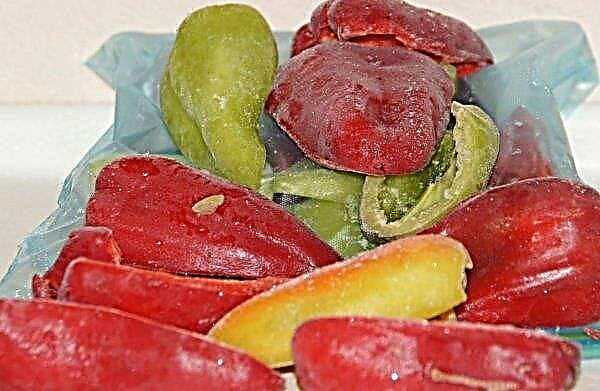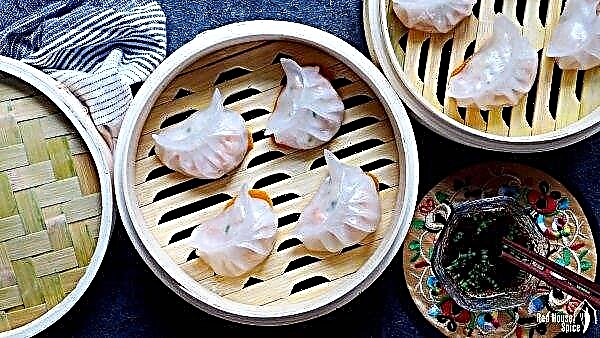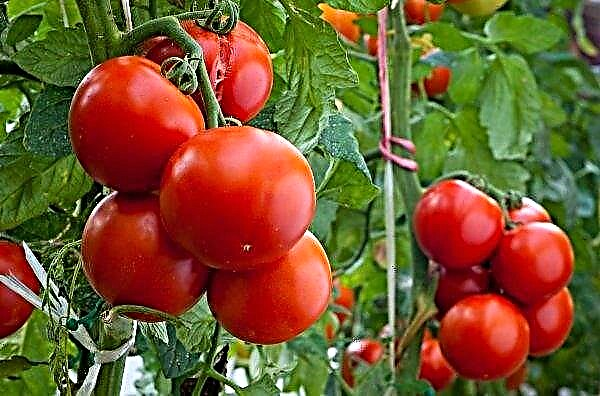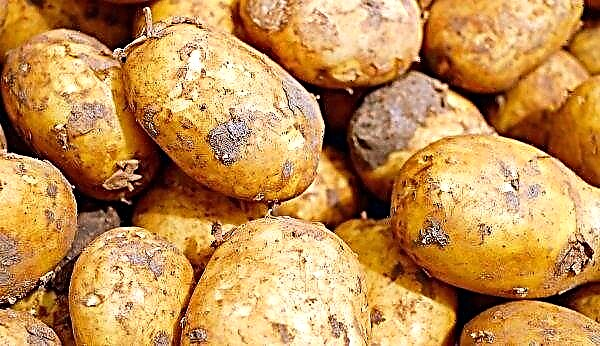Today in the article we will figure out how to independently propagate cyclamen in apartment conditions, when is it better to do it, and also which way to choose. Consider the possible difficulties encountered during this process, and further care for the plant.
Short flower description
Cyclamen is a perennial herbaceous culture, which is a corm in a round, slightly flattened shape and belongs to the Mirsinov family. Under natural conditions, the plant can be found in the countries of the Mediterranean, Southern Europe, the Middle East, as well as on the Caspian coast. There are about 60 types of culture, but a third of them are grown in an apartment.
The plant is characterized by the presence of a large number of basal leaves of a heart-shaped, leathery in structure, dense. They have a dark green color and a silver pattern on the surface. The leaves are located on thin petioles, the length of which can reach 30 cm. They are collected in a neat outlet.Did you know? Cyclamen is popularly called "pork bread." The thing is that wild boars like to enjoy its tubers. Its official name is "cyclamen" — translated means "circle" — the flower received due to the round shape of the rhizome.

During flowering, bisexual flowers of an original form are formed on cyclamen, outwardly resembling a butterfly - the petals are slightly pointed and bent, they can have a fringed shape. From one bush per season, from 60 to 100 buds can ripen, which have the widest range of colors: white, pink, scarlet, burgundy, purple, purple. Flowering of one bud lasts 10-12 days. From the small beautiful flowers comes a pleasant delicate aroma reminiscent of the aroma of lily of the valley.
When and under what conditions is cyclamen best propagated
Breeding cyclamen can be done independently, in the home. It is recommended to start the process when the plant is in hibernation. Experts advise inexperienced growers to use the seed method for reproduction.
You can get the seeds yourself, but for this you need to pollinate the flower. When the flowers fade, it is necessary to wait for their complete natural drying. After that, shortly before it opens, get small seeds from the seed box.Regardless of the method of propagation (seed or tuber), seedlings need to provide conditions that are comfortable for growth:
- after planting, cover the seedlings with plastic wrap to ensure the effect of the greenhouse;
- place the container in a room with a stable temperature of +18 ... + 20 ° С. Low and too high temperature indicators will adversely affect the state of the sprouts, slow down their growth and development;
- Before the first shoots appear, the container with seeds or tubers may be in a poorly lit room, since during this period the light does not have much significance. However, as soon as the first seedlings hatch, the container should be moved to a place with bright diffused lighting;
- regularly before the appearance of sprouts, the container should be opened and ventilated. Periodically, it is necessary to moisten the soil with a spray gun;
- after the formation of sprouts, the container should be fully opened.

Preparatory work
Before proceeding with the cyclamen reproduction procedure, a number of preparatory work should be carried out:
- Pot selection. The plant does not need too deep containers, because the roots are not able to completely fill a large space, as a result of which they slow down growth. The best option for culture is a flat pot that resembles a bowl for soup or a bowl. Ideally, the new tank should be 2-3 cm in diameter larger than the old one. The material of the pot does not really matter. Must have holes for drainage.
- The soil. For planting a flower, you can use special soil designed for cyclamens, or prepare the soil yourself. Before use, the soil should be sterilized by any available method: warm in the oven for 10-15 minutes at a temperature of +180 ... + 200 ° С, spill with potassium permanganate solution and dry thoroughly, freeze it on the balcony or in the freezer.
- Instrument sterilization. Without fail, all tools that will be used during the plant breeding procedure must be disinfected. To do this, they are treated with special purchased disinfectants, wiped with an alcohol solution or soaked for several minutes in a solution of potassium permanganate.
Video: The intricacies of growing cyclamen
How to propagate cyclamen at home
To cultivate the culture at home, two main methods are used: by seed and tuber division. Note that the first method is more time consuming and lengthy.
Leaves
Many beginning flower growers spend time and effort to propagate the plant by leaf, rooting it in ordinary clean water, for example, like gloxinia. However, leafy cuttings of cyclamen do not allow root shoots: with prolonged exposure to water, they begin to rot or dry out.
In rare cases, cyclamen of the European variety can be propagated by leaf. However, the leaves must not be cut off, but broken off together with a small part of the tuber. On some leaves, you can sometimes notice small root roots, called “fingers”. If such leaves along with “fingers” are planted in the ground and the greenhouse growing conditions are organized for them, then they can take root.
Some types of cyclamen are deprived of leaves with roots, respectively, the method of propagation by leaves is not suitable for them.
Seeds
Cyclamen perfectly propagated by seeds. Material for breeding can be purchased in specialized stores or collected independently. In the latter case, the plant must be pollinated, since in an apartment there are no insects that in nature fulfill this function.
Using a cotton swab or a clean brush or tapping a flower, you need to take pollen from one flower and transfer it to the pistil of another. Pollination is advised to carry out 5-7 days in a row, on warm, sunny days. If everything went well, then after flowering on the plant, seed boxes will ripen on the plant.
Ripened seeds must be collected and immediately before sowing, soak for several hours in warm water.
To sow cyclamen seeds, experts advise to adhere to the following technology:- the soil mixture is poured into the tank, consisting of the same parts of peat and leaf soil with the addition of vermiculite;
- seeds are sown on the surface without deepening into the soil, and sprinkled with a small layer of earth, up to 1 cm;
- the container with seeds is covered with a film or glass;
- before emergence, the containers are placed in a room with a stable temperature of about + 20 ° C. If the temperature is below + 18 ° C, the seedlings will begin to decay, if above + 20 ° C, they will fall into a state of rest. But even with strict adherence to the temperature regime, the appearance of sprouts can be expected after 30–40 days, and sometimes after several months;
- in the process of growing seedlings, the container is regularly ventilated, and the soil is moistened;
- after the appearance of sprouts, the container is opened and placed in a well-lit place at a temperature of +15 ... + 17 ° C;
- when small tubers appear and the formation of full leaves, seedlings are planted in separate pots;
- a week after transplantation, the plant is fertilized using mineral products in a dosage half that indicated in the instructions.

Tuber division
To propagate cyclamen tubers for some species is undesirable, since this event requires certain knowledge and skills from the grower. The procedure is carried out during the rest of the plant - in spring or summer.
Before dividing the tuber, it is necessary to remove it from the pot, thoroughly clean it from an earthen coma and dry it.
Further, the event is carried out according to this algorithm:Important! When choosing tubers for propagation, they should be visually inspected: wrinkled, rotten, sluggish or with spots and damaged roots are not suitable.
- dried tuber is divided into several parts so that each of them receives at least one kidney and several root processes;
- places of cuts are dried, treated with activated charcoal or charcoal powder to prevent infection of tubers with infections;
- the resulting roots are planted in separate containers and covered with plastic wrap to create a greenhouse effect;
- in the presence of new processes on the tubers, the film is removed, the shoots are planted in new pots and provide appropriate care.

Features of plant transplantation and further care for it
Cyclamen needs replanting every 2-3 years. The event is held in late summer or early autumn, when the phase of intensive vegetation begins in the culture.
Cyclamen transplantation is not particularly difficult and is based on the following steps:Important! Regardless of the time of year, the flower brought from the store should be transplanted, if possible, after 10–12 days when the plant fully adapts to new conditions.
- a drainage layer is lined at the bottom of the pot using expanded clay or pebbles;
- the drainage layer is sprinkled with a small layer of soil. A light nutrient soil with a loose structure, specially designed for cyclamens, is used as a substrate. You can make a soil mixture on your own by taking 5 parts of leaf soil and 1 part humus, peat and sand. Chalk or wood ash is also added to the mixture;
- carefully remove the tubers from the old tank so as not to damage the tubers, examine the root processes - dead, rotten, diseased and dry roots are cut, the places of the cuts are treated with charcoal;
- the young plant is immersed in the ground completely, covering the tubers. In adults, the upper third of the tubers is left above the surface;
- the culture is sprinkled with the rest of the earth and placed in a warm, well-lit place, protecting from the rays of the sun and drafts.
Video: How to transplant cyclamen at home
After transplanting cyclamen, it is necessary to organize comfortable conditions:
- Watering. The first watering after transplantation is recommended after 10-14 days. Next, the plant is moistened as the topsoil dries. The optimal irrigation scheme is considered 1 time in 3-4 days. For a flower, both waterlogged and overdried soil is detrimental. In the first case, the root system rots, in the second - leaves fall and turn yellow. The best method of moistening is considered to be the drip tray, when moisture is poured directly into the tray, and excess water is drained. For irrigation, it is necessary to use soft defended water with temperature indicators of +18 ... + 22 ° С. During the dormant period of a flower, the number of waterings should be reduced.
- Top dressing. In the phase of intensive growth and flowering, cyclamen needs high-quality nutrition. It reacts positively to minerals and natural organic complexes. Throughout the growing season, fertilizer should be applied every 10-14 days. Before applying dressings, for 30 minutes, experts recommend watering the flower with plain water. In a dormant period, fertilizer should be discarded.
- Temperature and lighting. Cyclamen prefers cool temperatures - from +6 to + 12 ° C in winter. In summer, it is recommended to grow a flower at room temperature, avoiding heat and heat. The best place for a plant is considered to be the windows on the east and west sides of the apartment, where diffused bright lighting prevails. When placing the culture on the windowsills on the south side, it should be protected from direct sunlight.
- Humidity. Cyclamen is a moisture-loving plant. In the period of intensive growth, in addition to traditional irrigation, he is satisfied with spraying. To increase the humidity in the apartment, it is recommended to put a flower on a pallet with pebbles in the water. In winter, the plant should be located away from heating appliances and batteries.
Did you know? The duration of cultivation of cyclamen in the home is 7 years. After that, even with proper care, it is no longer suitable for breeding, and a new, young plant should be acquired.
What difficulties may arise
When growing cyclamen, some difficulties may arise, which are most often associated with non-compliance with the basic rules for caring for a plant.
Signs of a culture disease are:
- yellowing of leaves, falling of flowers - indicates untimely moisture;
- yellowing of the leaves, while the peduncles remain healthy - indicates an increased temperature in the room. To restore the culture, it is necessary to reduce temperature indicators;
- gray rot on the leaves and stalk - appears due to increased humidity and at low temperature indicators;
- flowers and leaves rot - indicates excessive moisture in the soil.

Useful Tips
Cyclamen is quite sensitive to living conditions, so beginner growers in the process of growing can encounter a number of difficulties that can be avoided by expert advice:
- For plant propagation, you should choose high-quality material. Seeds should be without damage, dense structure; tubers - elastic, hard, without rot.
- In the home, cultivating a crop is recommended by seeds or tubers.
- During the germination of seedlings, special attention should be paid to the condition of the soil - it should always be slightly moistened, as well as temperature - it should be in the range +18 ... + 20 ° С.
- The ideal soil mixture for sprouts is the symbiosis of leafy soil, humus and peat. Cyclamen reacts negatively to alkaline soils, so it is recommended to add chalk or wood ash to the substrate.
Did you know? The cyclamen is called the flower of inspiration and joy. It is believed that in apartments where this plant is, always reign calmness, peace and harmony. Culture is capable of absorbing negative energy and giving away positive.
Cyclamen is a fragile and picturesque ornamental plant, which is distinguished by lush flowering. Its delicate flowers have a wide range of colors and a pleasant lavender aroma. However, so that the culture does not lose its aesthetic appeal, it needs to organize the right care, which consists in monitoring the condition of the soil, lighting, temperature and humidity.



